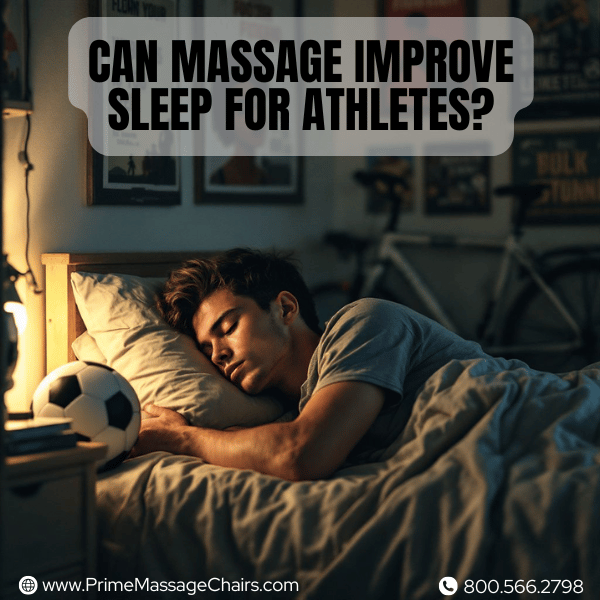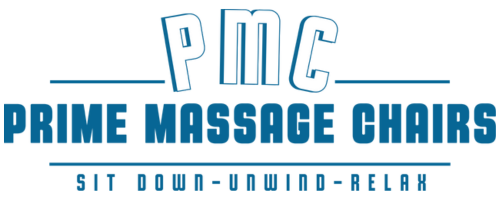
Can Massage Improve Sleep For Athletes?
Can massage improve sleep for athletes? This is a question many athletes may ask as they look for ways to feel more rested.
This article explores how massage may support better sleep in athletic routines.
Keep reading to learn more!
The Connection Between Sleep and Athletic Performance
Rest may be very important for athletes who wish to perform at peak levels.
Securing 7-9 hours of nightly rest may aid muscle repair, may improve memory, and may help maintain proper hormone levels. Such factors could promote both power and alertness.

Not getting enough sleep may delay reflexes and could increase an athlete’s chance of harm. It could also lower power and might affect mood and focus.
This link between proper rest and sports achievement may underline why downtime is vital for all competitors.
How Massage May Improve Sleep for Athletes
Massage may aid an athlete’s rest by promoting calm and could relieve muscle discomfort through each session, possibly ensuring they could practice or perform effectively.
It may support circulation, could help regulate sleep hormones, may reduce tension, could ease aches, and may carefully target stubborn areas through specialized techniques.
Such as sports massage, deep tissue, Swedish approaches, and trigger point therapy.
Reducing Stress and Promoting Relaxation
Feeling anxious may disrupt an athlete’s ability to fall asleep with ease. Massage treatments may reduce tension by curbing cortisol, the body’s primary stress chemical.
Swedish and deep tissue styles may help quiet the body and mind, possibly paving the way for improved rest.
Regular massages may boost serotonin and dopamine, chemicals that could enhance a person’s mood.
That may let athletes wind down at night and could loosen muscles. Including massage in one’s schedule may aid mental well-being and rest alike.
Easing Muscle Tension and Pain
Massage therapy may ease sore muscles and pain for athletes. Intense exercise may lead to sore muscles.
Massages could loosen those strained muscles. They may also aid the body in removing certain byproducts, possibly speeding recovery and cutting down on overall stiffness.
Sports massage may focus on deep muscular tension. Practitioners may apply targeted techniques to access tight spots, which could let them unwind more than standard methods.
Such an approach may reduce inflammation, possibly aiding athletes in achieving improved sleep.
Enhancing Circulation
- Frequent sports massage may boost the body’s circulation. That may allow muscles to gain oxygen and nourishment.
- It may also aid the body’s waste removal. For athletes, this could enhance their results and rest.
- Improved blood flow may ease tension and pain. That may prepare athletes to achieve rest once they finish intense training. Keeping hormones steady may be crucial for rest.
Supporting Hormonal Balance for Better Sleep
Massage sessions may support rest by increasing melatonin, a key hormone that may signal the body that bedtime has arrived.
That change could allow athletes to drift off and enjoy deeper slumber. This approach may also boost serotonin and dopamine, chemicals that could encourage relaxation and a stable mindset.

Aromatherapy and Swedish sessions may be effective here, as they may apply mild pressure and soothing fragrances to help quiet thoughts.
Such treatments may stabilize melatonin release, possibly assisting in correcting sleep cycles for individuals.
For that reason, athletes may rise feeling fully prepared to tackle upcoming matches or workouts.
Types of Massage Beneficial for Athletes
Massages may help athletes in many ways, from easing muscle tightness to supporting blood flow and recovery after workouts.
The effects of massage may vary depending on the type, how often it’s used, and each individual’s response.
- Some massages may help loosen tight muscles.
- Others may support blood flow or help with healing from sports stress.
Sports Massage
Sports massage may help athletes before games, during training, and after activity. It could make muscles more flexible, ease stiffness, and support better mood and sleep.
Therapists may use methods like Swedish strokes, kneading, pressing on tight spots, and working on trigger points.
This therapy may help with motion and lessen muscle tightness, which could support better rest.
Sports massage may support blood flow and play a role in lowering the chance of injury, though results may vary from person to person.
Athletes wanting better rest and improved results may benefit from regular sessions.
Massage therapy is not a replacement for medical care. Always ask a health expert before starting a new routine.
Deep Tissue Massage
Deep Tissue Massage may work into deep muscle and nearby tissue, but it may not be suitable for everyone, especially those with certain medical conditions like clotting disorders.
Athletes with soreness or injuries may find it helpful. It may ease long-term back pain and, over time, could help lessen lower back discomfort during pregnancy.
Still, this kind may feel intense, so it's important to talk with the therapist to make sure it feels right.
Using slow, strong strokes, Deep Tissue Massage may ease body tension. Athletes may feel less soreness and recover better from exercise or injury care.
This may also help with sleep. Always check with a licensed therapist or health provider to see if deep tissue massage fits your needs.
Other types of massage may also help athletes sleep better and feel stronger overall.
Swedish Massage
Swedish massage is meant to ease stress and help people relax. It uses long strokes and kneading to support blood flow and muscle ease. Getting this kind of massage once a month may support overall well-being.

This type of massage may help ease back and neck pain based on general observations.
It could lower stress hormones and raise feel-good ones like serotonin and dopamine, which may help athletes rest better and recover quicker.
Results depend on each person and are not medical advice.
Trigger Point Therapy
Trigger Point Therapy looks at tight spots in muscles that may affect performance.
The evidence supporting its effectiveness is mixed, and more research may be needed to draw strong conclusions.
These spots may come from injury, bad posture, or joint issues. This therapy may help improve blood flow and reduce waste in the area.
It may help athletes with pain by supporting muscle balance and healing. It could also encourage relaxation and better sleep. Rest may support athletic performance by helping muscles heal.
So, Trigger Point Therapy may work well for athletes who want better rest and improved results.
Talk to a trained therapist or health pro to make sure it’s done safely and correctly.
Best Practices for Incorporating Massage into an Athlete’s Routine
Planning massage sessions around training and rest may help athletes sleep better.
-
Pairing massage with healthy sleep habits could support rest and athletic performance.
Timing Massage Sessions for Maximum Sleep Benefits
Having a massage in the evening, about an hour before bed, may help calm the body.
A quiet space with soft lighting, relaxing scents, and gentle music may make it even more soothing.
Doing this often may help make sleep deeper and part of a regular bedtime habit. This habit may lead to better, longer sleep.
These are not medical treatments and results may differ by individual.
Combining Massage with Other Sleep Hygiene Techniques
Keeping a steady bedtime and calming nighttime routine may help athletes rest more. Make bedrooms dark, cool, and quiet.
Adding stretching and soaking in warm water after massage may boost the benefits. Stretching may help loosen muscles further, and warm baths may relax the body, supporting recovery from physical strain.
These practices paired with massage could help athletes rest and recover better.
Ask a health or wellness expert for advice for best results.
Additional Benefits of Massage for Athletes Beyond Sleep
Massage may help athletes feel better faster and support movement, which could play a role in injury prevention.

It should be used alongside other recovery and injury prevention practices for best results.
It could be a helpful tool for athletes who want to improve workouts and stay physically strong.
Faster Recovery Times
Sports massage may support recovery after hard workouts. It may reduce tiredness and help muscles prepare again by improving blood flow. This could help muscles get more oxygen and nutrients.
Regular massage may help limit tightness, soreness, or pain from sports. It might even help with delayed onset muscle soreness (DOMS). Keeping muscles healthy this way could lower injury chances.
Improved Flexibility and Range of Motion
Getting massages regularly may help athletes bounce back quicker, possibly improve flexibility, and support better joint movement.
This could improve sports performance. Some massage moves may stretch muscles and support joint mobility, helping athletes move more easily.
Massage may help muscles stretch better, possibly lowering the risk of injury. It may also reduce tightness, helping athletes move easier during training or events.
These benefits may help lower the chances of strains or sprains and help athletes grow in their sport more safely.
Massage Chairs and Their Potential Benefits
Massage chairs may offer an alternative way to experience some of the benefits of massage therapy.
They could help relax muscles and may improve blood flow while providing a gentle, automated massage.
Some users may find that using a massage chair could help them feel calmer and more at ease before sleep, although results could vary by individual.
For that reason, athletes may rise feeling fully prepared to tackle upcoming matches or workouts.
FAQs
1. How Can Massage Therapy Benefit Athletes?
Massage therapy, including sports and deep tissue massage, may offer benefits to athletes.
It could support flexibility and circulation, promote relaxation for stress relief, and assist with injury recovery.
2. Can A Good Night's Sleep Improve An Athlete's Performance?
Yes! Quality sleep may be important for both physical and mental recovery. It could help athletes of all levels recover more effectively from physical activity or aerobic exercise.
3. Does Massage Therapy Have Any Impact On The Quality Of Sleep For Athletes?
Massage therapy may promote relaxation, which could lead to improved sleep quality and help athletes feel more refreshed.
4. Are There Different Types Of Massages That Could Help Improve An Athlete’s Sleep?
There are various massage techniques like sports massage or manual therapy that may support better rest by easing muscle tension.
5. Is It Necessary For Professional Athletes Only Or Even Weekend Warriors Can Experience The Benefits Too?
Massage therapy may benefit both professional athletes and recreational ones. Weekend warriors may also find relief from soreness and stress through regular massage sessions.
6. Who Should Perform These Therapeutic Massages On Athletes?
It’s best if licensed therapists with experience working with athletes perform these massages.
They may better understand the physical demands of sports and how to adjust techniques accordingly.
Conclusion
Can massage improve sleep for athletes? Massage therapy may help by promoting relaxation, reducing muscle discomfort, and supporting better circulation. These effects could contribute to improved sleep quality.
Combining massage with other healthy sleep habits, like keeping the room cool and reducing screen time before bed, may support deeper rest and better athletic outcomes.
For athletes focused on recovery, adding massage to their wellness routine could be a helpful strategy.
Disclaimer:
We do not provide medical advice. The content of this article, including text, graphics, and other material, is for informational purposes only. It is not intended to be a substitute for professional medical advice, diagnosis, or treatment. Always seek the advice of your physician or other qualified health provider with any questions you may have regarding a health condition. Never disregard professional medical advice or delay in seeking it because of something you have read in this article or on our website.
